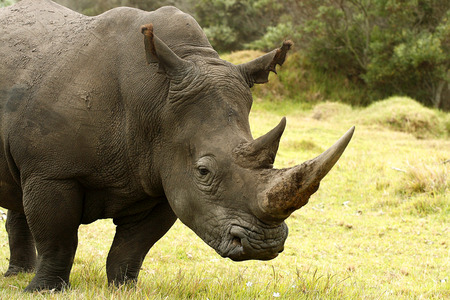3D-printed Rhino Horn Could End Poaching

November 1, 2016
As 3D printing technology continues to improve, it could combat the ongoing problem of rhino-horn poaching, which has become a crisis that is contributing to rhinoceros extinction. Bioengineered replicas of rhino horn — in addition to a variety of other anti-poaching initiatives — could help save what’s left of the rhino population.
Instead of trying to end the illegal trade of rhino horn, some innovators are working to flood the black market with 3D-printed replicas. According to Matthew Markus, co-founder of Pembient, an organization that helps end illegal trade of wildlife goods by recreating them in a lab, the 3D-printed horns will be as biologically close to the real ones as possible, but will sell for one-tenth the price. (Pembient is also working on bioengineering elephant tusks to combat poaching for the illegal ivory trade.)
Poaching has increased in South Africa and Asia due to high demand, which has led to a decline in the rhino population. Usually poachers will kill the rhino or saw off the horn, leaving it to bleed to death, according to the Save the Rhino Organization.
The desire for horn stems from many areas. More than 1800 years ago, it was common in China to prescribe rhino horn powder for fevers and liver problems, but in the mid-1990’s, there was a ban on the use of rhino horn in China.
Now Vietnam is one of the biggest consumers of rhino horn. In the mid 2000’s, a Vietnamese politician claimed that the use of rhino-horn powder cured his cancer. Although there was no scientific proof of that, it caused an increase in demand.
According to the Convention on International Trade in Endangered Species, the rise in the purchasing power of the wealthy has created a new market for rhino horn. It is seen as a status symbol, with its price tag exceeding even the price of gold, at approximately $60,000 per kilogram (2.2 pounds). Since a new higher standard of living has led to an increase in alcohol consumption, people want the powder because they believe it will help their livers, according to Tom Milliken, an expert on the rhino market.
How it’s made
Rhino horn is primarily made of keratin, which is a fibrous protein that provides the structure of hair, nails, feathers, hoofs, etc., in people and animals. Synthetic rhino horn is made primarily from wool keratin. Markus’s plan is to engineer yeast cells to produce the same kind of keratin as natural horn. He would insert a gene that would code keratin into yeast, thus making the fungus easily manufactured.
Pembient is trying to isolate the genes needed to create rhino-horn keratin by finding the genome of the white rhino as an example. Pembient is also trying to get access to the DNA of black rhino horn to learn if there are major differences in their make-up. The next step would be to combine the keratins with other components of rhino horn. This material would then become the “ink” for the 3D printing.
There is hope that this fake horn will be more desirable since it would be lower priced and wouldn’t contribute to rhino endangerment. Another benefit would be that it wouldn’t contain pesticides, industrial chemicals, or radioactivity from past nuclear accidents, which can all be found in natural horn, according to Markus.
Opposition
Some believe these synthetic horns will not help to end the poaching and have the
potential to make it worse than it already is. Douglas Hendrie, the manager of the wildlife crime and investigations unit for the conservation group Education for Nature- Vietnam, explains that even though the synthetic horn will be on the market, people will still buy it from the actual source and still feed into the illegal trade. In addition, it would be difficult for law enforcement to regulate this commercial trade. Hendrie explains that in Vietnam, it is hard enough for law enforcement to regulate the black market let alone when it’s actually legal trade.
In addition, the engineered rhino-horn powder could become an easy target for mislabeling, since sellers could pass it off as other substances. This has caused Pembient to focus on recreating the full intact horn since that is what is most desired.
More methods
Other techniques to stop rhino-horn poaching include options such as infusing toxins and dye into the horns of living rhinos to make them undesirable. The toxin would make human consumers sick while the dye would devalue their aesthetics. In South Africa, a study has been conducted using these techniques on private reserves, and they have proven to reduce poaching, according to Lorinda Hern, the co-founder of the Rhino Rescue Project.
Drones are also being used to catch poachers. In South Africa, drone protection is provided by the Lindbergh Foundation. They use predictive software to show where the animals or poachers are most likely to be so rangers can be ready at any time.
But according to foundation chairman John L. Peterson, the drones haven’t been too successful since they can crash or get lost. In addition, the ground rangers need to be better equipped since they don’t always have the necessary equipment to pursue poachers.
Right now one thing’s for sure: If the rhino is allowed to become extinct, it will be gone forever.

